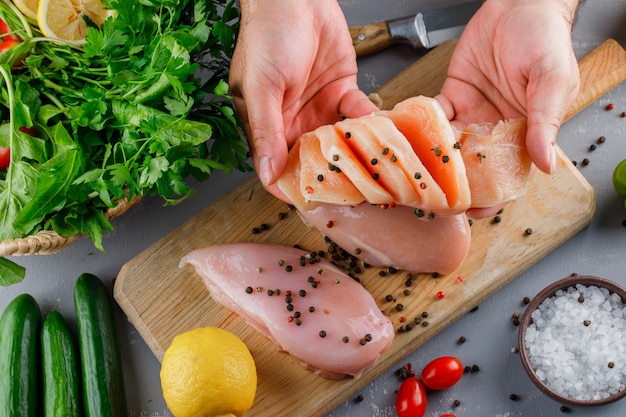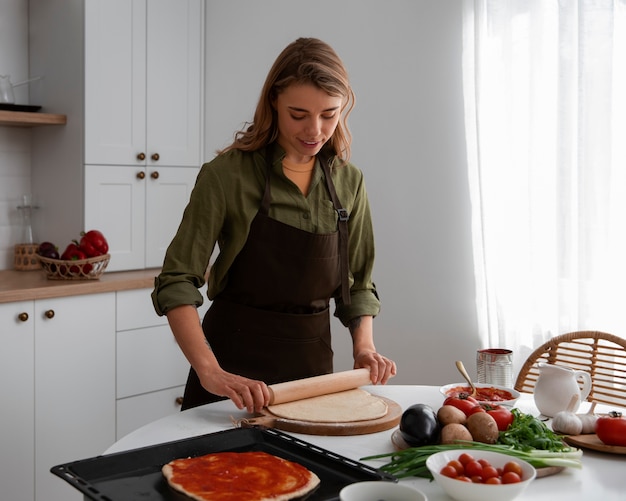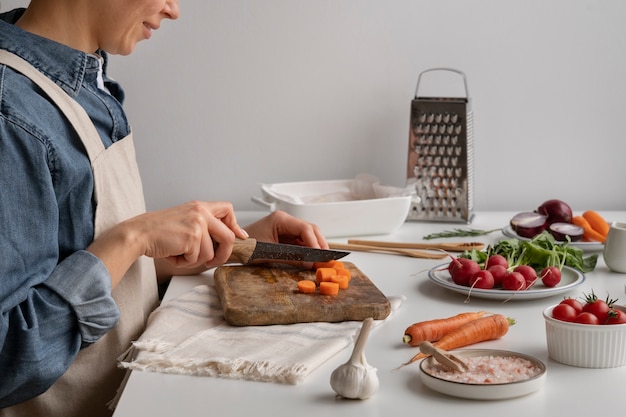Right, you want to know how to cook perfect crab legs at home, eh? You've come to the right place! I've been a bit obsessed with seafood for as long as I can remember, and crab legs are definitely a top contender. Over the years, I've tried countless methods and recipes, and I've learned a thing or two about getting those sweet, juicy morsels just right.
In this guide, I'm going to share all my secrets, from choosing the best crab legs to steaming them to absolute perfection. I'll also give you some tips on serving them up with delicious sides and sauces that'll have everyone coming back for seconds. Grab a cuppa, settle in, and let's dive into this delicious adventure!
(Part 1) Choosing the Perfect Crab Legs

The first step to delicious crab legs is choosing the right ones. It's a bit like picking the perfect ripe fruit - you want to look for signs of freshness and quality. Here's how to ensure you get the best crab legs for your money.
Where to Buy Crab Legs
You can usually find crab legs in the frozen section of most supermarkets, but I'll be honest, it's usually a bit of a gamble. The quality can vary, and you're often left wondering if they've been frozen multiple times. Personally, I always head to my local fishmonger. They'll have a better selection, and often have fresh crab legs. They can also give you some tips on how to cook them, which is always a bonus. If you're lucky enough to live near the coast, you might even be able to find them fresh from the boat - that's the ultimate treat!
types of crab legs
There are a few different types of crab legs to choose from, each with its own unique flavour and texture. Here's a rundown of the popular contenders:
- King Crab: These are the giants of the crab world, with thick, meaty legs. They're a bit pricier, but definitely worth it for a special occasion. Their flavour is intense and sweet, and the meat is wonderfully succulent.
- Snow Crab: snow crab legs are smaller than king crab legs, but don't let their size fool you! They're still packed with flavour, boasting a delicate sweetness that's irresistible. They're a fantastic choice if you're looking for something more affordable.
- Dungeness Crab: dungeness crab legs are a bit more delicate than their king and snow crab cousins, but they have a rich, sweet flavour that's truly unique. They're perfect for those who appreciate a more refined crab experience.
What to Look For
When choosing crab legs, here's what to keep in mind to ensure you're getting the best quality:
- Freshness: Fresh crab legs have a slightly sweet, briny smell, almost like the ocean breeze. If they smell fishy or ammonia-like, they're not fresh and should be avoided.
- Colour: Fresh crab legs should be a bright red or orange colour. If they're dull or faded, they may not be as fresh.
- Weight: Choose legs that feel heavy for their size. This means they're packed with delicious meat.
- Shell: The shell should be intact and not cracked or broken. A cracked shell can indicate damage or handling issues.
(Part 2) Preparing the Crab Legs

You've chosen your perfect crab legs - congratulations! Now it's time to prepare them for cooking. Here's how to get them ready for their starring role in your seafood feast.
Thawing
If your crab legs are frozen, you'll need to thaw them before cooking. The best way to do this is to put them in the refrigerator overnight. It's a slow and gentle process that ensures the meat retains its moisture and texture. You can also thaw them in cold water, but make sure to change the water every 30 minutes or so to prevent bacterial growth.
Avoid thawing them at room temperature - it's a recipe for disaster! The meat can become mushy and lose its flavour. Also, while it's possible to cook crab legs from frozen, the texture won't be as good as if they're thawed properly.
Cleaning
Once they're thawed, give your crab legs a good rinse under cold water. If you notice any dirt or debris, you can use a small brush to clean them. It's important to remove any impurities before cooking to enhance the flavour.
If you're using fresh crab legs, you'll need to clean them properly. This involves removing the stomach sac, often called the "dead man's finger," which is a small, greyish sac that can have a slightly bitter taste.
To remove the stomach sac, carefully insert a small knife into the top of the crab leg and cut along the joint to expose the sac. It's usually quite easy to pull it out with your fingers.
(Part 3) The Best Way to Cook Crab Legs

There are a few different ways to cook crab legs, but I reckon steaming is the best way to get them nice and tender, with the delicate flavour preserved. Here's what you'll need and how to get it done.
Equipment
You'll need a large pot with a steamer basket or a colander that fits inside. You'll also need a lid that fits tightly on the pot to trap the steam and ensure even cooking.
Ingredients
You'll need:
- Crab legs
- Water
- Salt (optional)
- Lemon wedges (optional)
- Fresh herbs (optional)
- Garlic (optional)
- Butter (optional)
The optional ingredients are there to add extra flavour to your steam, but they're not essential. You can keep it simple with just water and salt, or go for a more aromatic steam with herbs and garlic.
Instructions
Here's how to steam your crab legs to perfection:
- Fill the pot with about 2 inches of water and bring it to a boil.
- Add salt, lemon wedges, fresh herbs, and garlic to the water if you like. These ingredients will infuse the steam with their flavours, creating a more complex and aromatic taste for your crab legs.
- Place the crab legs in the steamer basket or colander. Make sure they're not overcrowded - they need space to cook evenly.
- Cover the pot and steam the crab legs for 8-10 minutes, or until the meat is cooked through and the shells are bright red.
- Once they're cooked, remove the crab legs from the steamer and serve them immediately.
cooking time can vary depending on the size of your crab legs. Smaller legs will cook faster, while larger legs will take a bit longer. The best way to check if they're done is to give the leg a gentle tug. If the meat comes away easily from the shell, they're ready!
(Part 4) Serving and Enjoying
Now comes the fun part - serving your perfectly cooked crab legs. It's a real feast, and I've got a few tips to make it a truly special meal.
Serving Ideas
Here are a few ideas for serving your crab legs, from the classic to the adventurous:
- Classic: Serve the crab legs with melted butter for dipping, alongside some lemon wedges for squeezing. This is a classic for a reason – it's simple, delicious, and lets the flavour of the crab shine.
- seafood boil: If you're feeling adventurous, try a seafood boil. This involves cooking the crab legs with other seafood like shrimp, mussels, and potatoes. It's a fun and festive way to enjoy crab legs, perfect for a gathering of friends or family.
- Spicy: Add some heat to your crab legs with a spicy dipping sauce. I like to make a mix of mayonnaise, sriracha, and lemon juice. You can also add some chopped cilantro or scallions for extra flavour. This is a great way to spice things up for those who like a little kick.
Sides
Don't forget about the sides! Here are a few ideas to complement your crab legs, adding a touch of balance and flavour to your meal.
- corn on the cob: The sweetness of corn on the cob is a perfect match for the salty flavour of crab legs.
- Red Potatoes: These are a classic side dish for seafood boils, adding a hearty element to the meal.
- green beans: steamed green beans add a refreshing and healthy element to your meal, providing a nice contrast to the richness of the crab legs.
Tools
You'll need a few tools to help you crack open those crab legs and get to the delicious meat inside. Don't worry, you don't need anything fancy. Here's what I use:
- crab crackers: These are special tools designed for cracking open crab legs. They come in various sizes and designs, so you can choose one that fits your hand comfortably. You can find them at most kitchen stores.
- Nutcracker: If you don't have a crab cracker, a nutcracker can also do the job. Just be careful not to crush the legs too much, as this can make it difficult to extract the meat.
- Fork: Use a fork to pick out the meat once you've cracked the shell. It helps to gently pry the meat away from the shell, making it easier to enjoy.
Table Etiquette
Now, eating crab legs can get a little messy. It's a real finger-lickin' good experience, but there are a few etiquette rules to keep in mind. It's perfectly fine to use your fingers to eat the meat, but try to avoid licking them too much at the table, especially in formal settings. If you're at a formal dinner, it might be best to use a small fork.
(Part 5) Storage and Leftovers
You've cooked your crab legs, and you've enjoyed a delicious feast. But what about the leftovers? I've got some tips for storing those precious crab legs so they'll still be tasty the next day.
Storing Cooked Crab Legs
If you have any leftover cooked crab legs, it's best to refrigerate them as soon as possible. You can store them in an airtight container or wrap them tightly in plastic wrap. They should last in the refrigerator for 3-4 days.
Reheating
To reheat leftover crab legs, you can either put them back in the steamer for a few minutes, or you can microwave them. Just be sure not to overcook them, or the meat will become dry. A quick blast of steam or a short microwave session will bring them back to life.
Freezing
If you're not going to eat the leftover crab legs within a few days, you can freeze them. To freeze, wrap the cooked crab legs tightly in plastic wrap and then place them in a freezer bag. They should last in the freezer for up to 3 months.
When you're ready to eat them, thaw them in the refrigerator overnight and then reheat them as described above. Freezing and thawing can change the texture slightly, but it's a great way to save leftovers for later.
(Part 6) Recipes and Variations
You've got the basics down, but now let's get a little creative! Here are some recipe ideas and variations to try for a bit of extra flavour and fun.
Garlic Butter Sauce
This classic sauce is a perfect match for crab legs. Simply melt butter in a saucepan, then add garlic, chopped parsley, and lemon juice. Stir until the garlic is fragrant and the butter is emulsified, creating a creamy, flavourful sauce.
Spicy Cajun Sauce
If you like your food with a kick, try this spicy Cajun sauce. Combine mayonnaise, sriracha, lemon juice, and chopped green onions. You can adjust the amount of sriracha to your liking - start with a little and add more if you want it hotter.
Lemon and Herb Butter
For a lighter, more refreshing sauce, try this lemon and herb butter. Mix softened butter with chopped fresh herbs like dill, parsley, and chives, along with lemon zest and juice. It's a delightful combination of tangy and herbaceous flavours.
(Part 7) Tips and Tricks
Here are a few tips and tricks to make cooking crab legs even easier and more enjoyable:
Choosing the Right Pot
The size of your pot is important. You need a pot that's large enough to hold the crab legs without overcrowding them. Overcrowding will prevent the steam from circulating properly, resulting in unevenly cooked crab legs.
Don’t Overcook
One of the biggest mistakes people make when cooking crab legs is overcooking them. Overcooked crab legs will be dry and tough. So, keep a close eye on them, and don't cook them for longer than the recommended time.
Crack the Legs Carefully
When cracking the legs, be careful not to break them into too many pieces. If you break the leg, the meat might fall out, making it more difficult to extract. Use a firm but gentle hand when cracking the legs.
Serve with Wet Wipes
Don't forget the wet wipes! Eating crab legs can be a messy affair, so having some wet wipes on hand is a good idea. It'll make cleaning up a breeze, and you can fully enjoy the experience without worrying about sticky fingers.
(Part 8) FAQs
I know you might have some questions about cooking crab legs, so I've put together a list of some frequently asked questions:
1. How do I know if crab legs are cooked?
The easiest way to tell if crab legs are cooked is by their colour. Cooked crab legs will have a bright red or orange colour. The meat will also be firm to the touch, and it will pull away easily from the shell.
2. What happens if I overcook crab legs?
Overcooked crab legs will be dry and tough. The meat will also be stringy and difficult to pull from the shell. If you're unsure, err on the side of undercooking - it's easier to reheat slightly than to salvage overcooked crab legs.
3. Can I cook crab legs from frozen?
Yes, you can cook crab legs from frozen, but the texture will not be as good as if you thawed them first. If you're short on time, cooking from frozen is an option, but thawing them beforehand will yield a more tender and flavorful result.
4. What’s the best way to store leftover crab legs?
Store leftover crab legs in an airtight container in the refrigerator. They should last for 3-4 days. Make sure to refrigerate them quickly to prevent bacterial growth.
5. Can I freeze crab legs?
Yes, you can freeze cooked crab legs for up to 3 months. Wrap them tightly in plastic wrap and then place them in a freezer bag. Freezing and thawing can change the texture slightly, but it's a great way to save leftovers for later.
Well, that's it, my ultimate guide to perfect crab legs at home! I hope you've found it helpful. Remember, the best way to get it right is to experiment. So go on, have a go at cooking some crab legs at home, and enjoy a delicious seafood feast. Happy cooking!
Everyone is watching

How to Cook Frozen Lobster Tails Perfectly: A Step-by-Step Guide
RecipesLobster. Just the word conjures up images of lavish meals, special occasions, and a taste of luxury. But let's...

Pigs in a Blanket Cooking Time: How Long to Bake for Perfect Results
RecipesAh, pigs in a blanket. Just the name conjures up images of those delightful little parcels of crispy pastry en...

Pork Fillet Cooking Time: How Long to Cook It Perfectly
RecipesPork fillet, or tenderloin as it's sometimes called, is a real favourite in our house. It's so versatile, and...

The Ultimate Guide to Cooking Delicious Frankfurters
RecipesLet's face it, we all love a good frankfurter. It's a classic, simple, and always satisfying. But let's be rea...

Wolf Meat Recipes: A Guide to Cooking Wild Game
RecipesLet's be honest, you don't see wolf meat at your local butcher shop every day. It's a bit of a wild card, but ...
